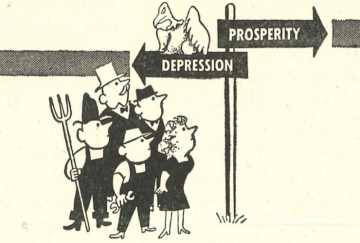 Robert Manduca in Boston Review:
Robert Manduca in Boston Review:
“Let’s bring our editorial microscope into focus on a very significant phenomenon,” the video begins. “The middle-income consumer.”
As a middle-aged white man comes into view, pushing a wheelbarrow full of recent purchases, the voiceover chronicles his recent exploits. “He has fed new demands into the production apparatus of industry, accounting for the housing boom, appliance sales, the rush for prepared foods.” Altogether, we hear, “the zoom in the American market after the war, the unprecedented volume of goods of all kinds, gobbled up by an insatiable tide of buyers, was largely the work of this middle-income man.”
After decades of praise heaped on “job creators,” viewers today may find it disorienting to see the consumer—and a middle-income one at that—cast as the hero of the economy, instead of the investor or the entrepreneur. Yet Fortune, which produced the video in 1956, was hardly an outlier. In the mid-twentieth century, advertising, popular press, and television bombarded Americans with the message that national prosperity depended on their personal spending. As LIFE proclaimed in 1947, “Family Status Must Improve: It Should Buy More For Itself to Better the Living of Others.” Bride likewise told its readers that when they bought new appliances, “you are helping to build greater security for the industries of this country.”
This messaging was not simply an invention of clever marketers; it had behind it the full force of the best-regarded economic theory of the time, the one elaborated in John Maynard Keynes’s The General Theory of Employment, Interest and Money (1936).
More here.
